
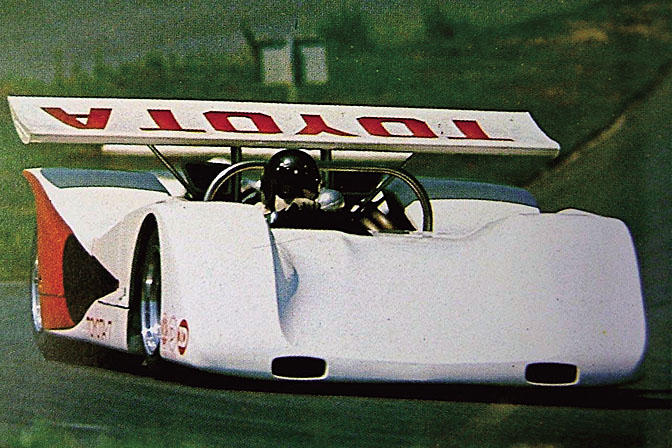
Motorsport is a funny way to make a living, driving round and round in circles, faster and faster if you get it right, or slower and slower if not. The dialogue in Steve McQueen’s classic Le Mans movie encapsulates the motivation behind those who drive the cars. “A lot of people go through life doing things badly……..Racing’s important to men who do it well. When you’re racing, it…..it’s life. Anything that happens before or after…..is just waiting.” Perhaps this philosophical approach was dictated by the cars that were driven back in 50s, 60s and 70s. They were dangerous, little or no protection was afforded the driver if he hit something solid, no crash boxes, no deformable structures and only rudimentary fire protection. The tracks themselves were also a major contributary factor with small errors often having fatal consequences. Yet the danger, the buzz attracted many, the siren song that lures us all on to the rocks.
Back in those decades the rules governing motorsport were a lot less proscriptive, more in tune with the notion that all things were possible. It was a time when a US President could commit his country to putting a man on the Moon within a short time frame and not be thought ridiculous, even though most of the technology did not even exist when JFK addressed Congress. It was the time of a “can do” attitude. Motorsport is a reflection of the society around it and the positive attitude was perhaps best reflected in what was the wildest and most extreme form of circuit racing, Group 7.
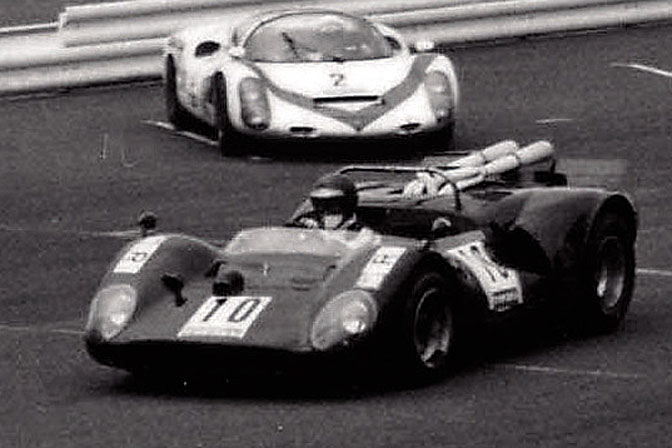
The name Can Am is probably more familiar than that of Group 7, bringing visions of insanely powerful open sportscars thundering around the traditional circuits of North America. It was however Group 7 rules that were the starting point for this competition. On SpeedHunters we have already had a peek at the summit of Can Am, the Porsche 917/10 and 917/30…
The Can Am Porsches, McLarens, Lolas, Chaparrals and Shadows are generally on the petrolhead radar but much less is known of the Japanese Group 7 scene. At the time the Japanese Grand Prix was run for sportscars and in 1968 the rules of Group 7 were adopted with the aim of eventually linking up with the wildly successful Can Am. This coincided with the tremendous expansion of the Japanese motor industry, so both Nissan and Toyota decided to get involved building up prototypes.
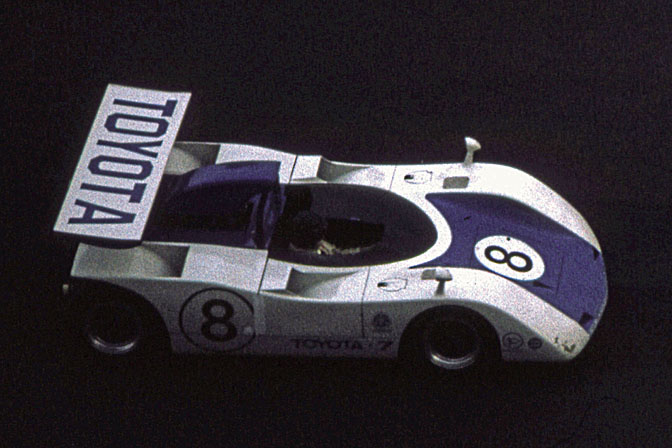
The original design for the Toyota 7 was down to Jiro Kawano, who was responsible for the 2000GT as featured on SpeedHunters earlier this month by the great Antonio. At that time Toyota and Yamaha collaborated in motorsport projects so construction and development were down to Yamaha. For the initial test a 2 litre straight six was installed that had been taken from the 2000GT.
The chassis was an aluminium tube frame construction with fibreglass bodywork. There was a 5 speed manual gearbox and a pretty conventional wishbone suspension set up. For actual racing a new all alloy 3 litre V8 was installed but this immediately put the Toyota at a disadvantage in 1968 as its Nissan and Lola rivals were running 5 litre V8 Chevys. This resulted in a horsepower deficit of around 150bhp and no matter how hard the 7 was driven it could only finish 5th in the Japanese Grand Prix.
But the team did not have to wait long for success as Sachio Fukuzawa and Hiroshi Fushida won the Suzuka 1000 kilometers late in 1968.
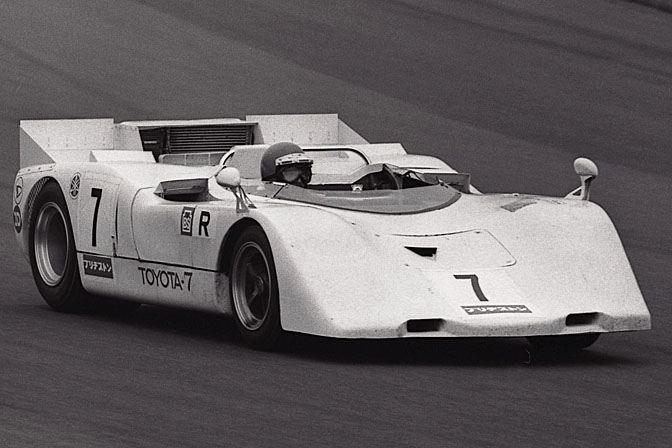
For the 1969 season the car was completely revised with a new 5 litre engine now giving out around 600bhp, a Chaparral style rear wing and new body work. It was a far more competitve prospect but Nissan had also been at work increasing their engine size in the never ending power struggle. As with the previous year Toyota had to give best to their rivals at the Japanese Grand Prix but then the hard work started to pay off with three victories in the balance of the season.
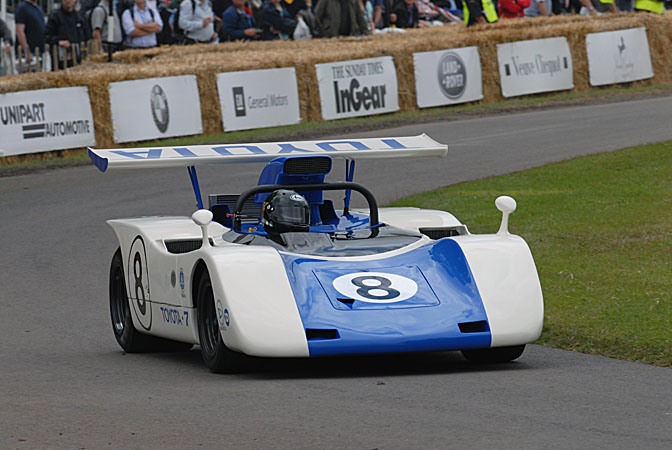
Toyota were rocked by the news that JAF had decided to make the 1970 Japanese Grand Prix a race for single seaters, effectively ending Group 7 in Japan. The project had also been badly affected by the death during a test session early in the year at the Yamaha test track of their star diver, Sachio Fukuzawa. Fukuzawa was testing an experimental coupe version of the Toyota 7 but the circumstances of his death were shrouded in mystery. Fukuzawa had a very high profile in Japan, being something of a fashion icon, he even modelled professionally and he made regular television appearances. The unwelcome publicity made Toyota very uncomfortable and the whole issue almost turned into a scandal and legal proceedings were issued by his family, but matters were settled before the case came to court.
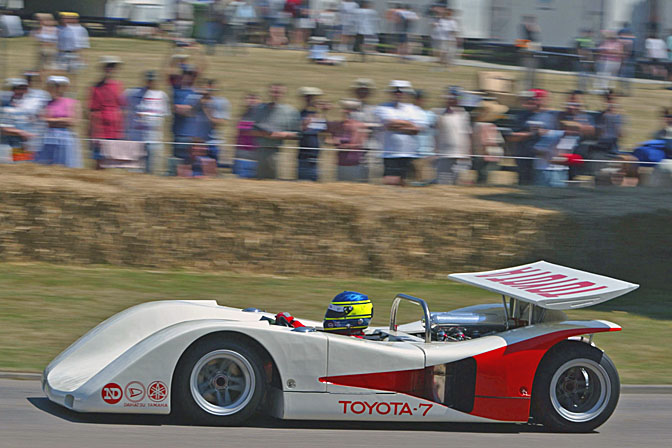
The JAF’s decision to go the single seater route may have closed down Japanese Group 7 but Toyota resolved to develop the car further and head across the Pacific to join the Can Am battle. To cope with the power of the 8 litre Chevys that the McLarens and other regulars used in North America, Toyota decided to add twin Garrett turbos to a new 5 litre engine, anticipating the Porsche 917/10 project by two years. The car now had more revised bodywork and aerodynamics to cope with the 800 plus bhp.
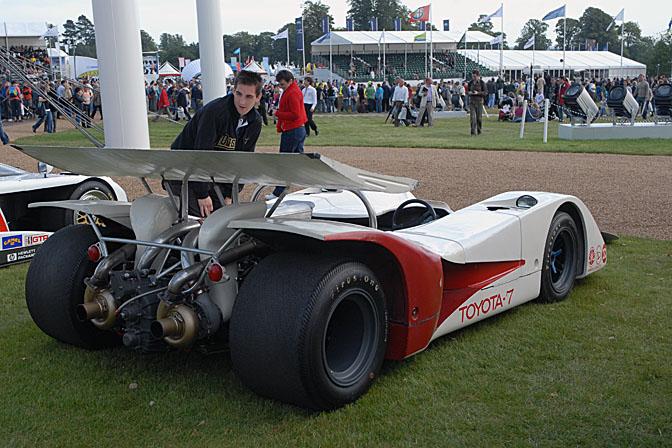
The misfortune that had dogged the project persisted and team leader Minoru Kawai was fatally injured after a high speed accident while testing at Suzuka in August 1970. Kawai, like Fukuzawa was a high profile figure in Japan, appearing in press and TV commercials for Toyota and was married to a leading actress, model and singer, Rosa Ogawa. The bad publicity arising from this second fatality was too high a price to pay for Toyota and the new car with the Can Am plan was cancelled.
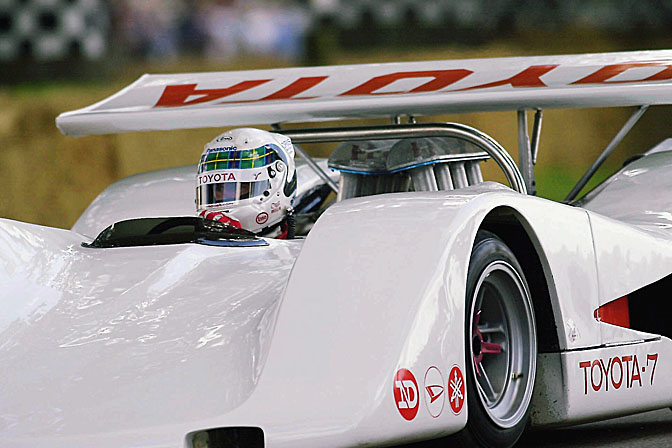
In researching this feature I found a shot of Allan McNish taking the 7 up Goodwood Hill at the 2002 Festival of Speed. I called him to get an impression of what it was like to drive.
“Terrifying.”
“How so?”
“There was no real throttle control, it was either on or off,”
He went on to say that the brakes were rudimentary at best and he lacked confidence that they would stop the car in time to get round the first corner on the hill climb. He also remarked on the lack of safety measures and was amazed to find that a similar car had won several long distance races including the Suzuka 1000 kilometres.
He remembered one other thing, the rear wing projected out either side of the rear bodywork around 20cms, one of the other drivers had not noticed and clipped a straw bale going up the Hill ripping the whole wing off…………….
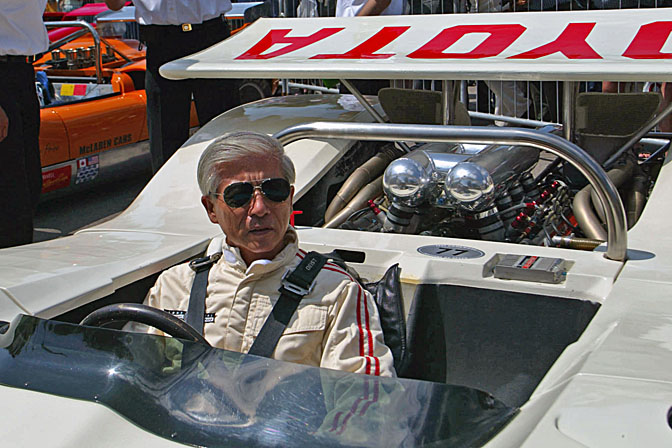
The late 60s and early 70s were a very dangerous time to be a top line racing driver, speeds had increased dramatically since World War Two but the safety measures had lagged behind until campaigners led by multiple Formula One World Champion, Sir Jackie Stewart, dragged the sport into the second half of the 20th Century. He was not always liked for what he agitated for.
“I would have been a much more popular World Champion if I had always said what people wanted to hear. I might have been dead, but definitely more popular”.
Allan McNish shares the same mix of intelligence and courage as his illustrious countryman and if he thinks a car is dangerous, it is, period.
Although it pales into insignificance compared with the human tragedy of two prematurely lost lives, we as SpeedHunters missed out what could have some of the greatest racing ever, a Can Am series with McLaren, Porsche, Shadow, Chaparral, Lola and Toyota, maybe Nissan would have followed. Motorsport might be a totally different landscape now.
The above photo show the Toyota 7 reunited with one of its original drivers, Hiroshi Fushida.
Toyota are rightly proud of the 7, it represented a significant jump in their motorsport history and proved that they had the ability to take on any manufacturer in the sport with a high chance of success.
John Brooks
All photos courtesy of and copyright Toyota Motor Corporation






The JAF may have decided to make the Japan Grand Prix an open wheel race in 1970, but the Group 7 series continued in 1970 without the Grand Prix event.
Suzuka 300 km, January 17-18, 1970.
Suzuka 1000 km, May 23-24, 1970.
Japan All Star Championship, October 9-10, 1970.
The JAF has results reported for these vents, Porsche, Lola, Ford, and others did quite well.
Toyota (and Nissan) bailed out of the series, but the series continued. Why brush aside the accomplishments of the other manufacturers in those events, and the existence of those events, just because Toyota (and Nissan) didn't come out to play with the rest?
love the turbo's, exhaust pipes?? who needs those??
It looks too much extreme... for those days and for nowadays.
An interesting side note.. notice the left side knock offs are red and the right Blue? Toyota did this on the racing 2000's also. It was to make sure that the correct side was always but on the correct side, so there was no cross threading issues. Still amazes me that more teams did not do this.
Also look at the second to last pic, and check out the mesh over the intake... Are those carbs up there? If so that is a hell of a long intake runner, that would cause at least some throttle lag. It appears to be the only picture of that engine setup... all the other pictures are different.
Thank you Mr. Brooks for another fine article.
Wow, I never new of this car. Awesome stuff.
My pick for the "Sexiest Japanese Race Car Ever" award! I remember it from Gran Turismo 4, I hope it returns in GT5! Love the detail in the wing mirror mounts on the '69 car, too cool!
Where are these historic race cars kept and how are they presevered so beautifuly?
Awesome! I love all the encarnations of Toyota 7, from the early prototypes to the final Turbo.
@ Dion ~ Most of these wonderful cars are owned by Toyota and kept on display or in storage at the Toyota Automobile Museum in Japan; occasionally they make public appearances and demonstration runs.
Once again SpeedHunters many thanks for your kindness.
@Komeko Like I suspect everyone else who follows this blog I was not personally involved at the time, so on topics from 1970 I have to rely on research. I was aware that racing continued from Group 7 in Japan, indeed there is some question as to whether Kawai's accident happened during a test prepraing to race but as the feature was on the Toyota 7 I do not see the relevance of commenting on races they did not compete in. Furthermore I would contend that any series in Japan that does not feature at least two out of the big three (Toyota, Nissan & Honda) is probably not worth bothering about.
@Foo2rama I think the car that McNish drove in 2002 was normally aspirated and that the turbo units were added when Toyota returned in 2003, the evidence for this is in the results and Allan did not remember the car having turbos.
jb
Oboyoboyoboyoboy! Thanks again John! I was fortunate enough to see a Nissan R382 at KN's Factory recently, which as a Nissan troll baked my cakes enough for a year or so. Might just have to try and find this'n now. We were planning to visit the Toyota place at Odaiba in the spring...
Pictures 6 and 8 in high res/wallpaper please!!
That car, in twin turbo form is just a nutsack on wheels! And I mean that in a good way lol
@ John Brooks & Foo2rama
I think what you are seeing between 2002 and 2003 (a normally asperate vs turbo unit) are NOT the same car. Several versions of the Toyota are still in existance and if you look at other detail of the cars in the photos, there are more differences.
You can try and learn more about the Toyota 7 if you check out this Japanese fan site:
http://www.mmjp.or.jp/60srace/TOYOTA7andSamurais.html
make sure to visit volume 2 and 3 also.
@ John Brooks
Your article claims that Toyota did not continue to participate in Group 7 in 1970, because the JAF ceased the series. But the series continued in 1970 and 1971 without Toyota. Your response to this fact is: "Furthermore I would contend that any series in Japan that does not feature at least two out of the big three (Toyota, Nissan & Honda) is probably not worth bothering about.". Are you telling us that your article was not written on a factual and historically accurate basis, and was instead written as fanboy fiction, ignoring the truth and anything that would take away from glorification of the subject? It reads like so many other half truth filled legend stories, the hero was born fully grown, never faced adversity, never lost, and retired undefeated. Reality is usually more gritty and more inspiring.
--------------
There are only a few reasons for a company to pull out of racing:
They knew they couldn't win.
They broke the rules and were forced to sit out as punishment.
Someone made a corporate decision to kill the racing program.
None of these match your story, that the death of a celebrity spokesman, who was not a professional driver, mechanic, or in any way vital to the racing program, and the mistaken claim that the series ended, caused Toyota not to continue competing.
So who was it that Toyota was afraid to face on the track?